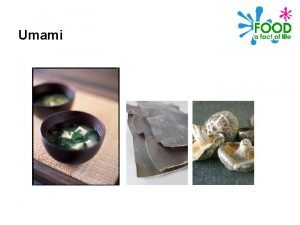Umami www foodafactoflife org uk Food a fact












- Slides: 12

Umami www. foodafactoflife. org. uk © Food – a fact of life 2019

What is umami? Umami is a savoury taste, often known as the fifth taste. It is a subtle taste and blends well with other tastes. Most people do not recognise the taste unless attention is especially drawn towards it. After eating Cheddar cheese or tomatoes, there may be a ‘savoury’ taste lingering - this is umami. Have you tasted umami? www. foodafactoflife. org. uk © Food – a fact of life 2019

How was it discovered? Umami was discovered by Dr Kikunae Ikeda, from Tokyo Imperial University, Japan, in 1908. He undertook research into Dashi, a traditional Japanese stock made from kombu (kelp). His research lead to describing the savoury taste as ‘umami’. He was sure that this taste was held in common by other foods with a savoury flavour, including those used in Western meals such as tomatoes and meat. Upon investigation it was discovered that these foods also had ‘umami’. www. foodafactoflife. org. uk © Food – a fact of life 2019

What is dashi? Dashi is a traditional stock used in Japanese cooking. It has been used for over 1, 000 years. Dashi is made from dried kombu (kelp), katsuobushi (dried bonito – fish) or dried shiitake mushrooms. Dashi means ‘boiled extract’. www. foodafactoflife. org. uk © Food – a fact of life 2019

How is dashi made? Japanese stock, dashi, is the key element of the authentic Japanese cuisine. The recipe is simple and quick! Ingredients 4 cm x 4 cm dried kombu (kelp) 600 ml water 8 g bonito flakes Method Make a few slits in the kombu and cook it in the water on a medium heat. Remove the kelp just before it boils and add the bonito flakes. Bring to the boil and strain. kombu bonito flakes Kombu dashi, made without the bonito flakes, is vegetarian. Vegetarian dashi can be made by soaking 2 -3 dried shiitake mushrooms in 600 ml of water for 1 hour. Drain and use. www. foodafactoflife. org. uk © Food – a fact of life 2019

Umami in Japanese cuisine Japanese miso soup Clear Japanese soup with shrimp Japanese miso soup Nishime Clear Japanese soup with shrimp Clear Japanese Nishim soupe with shrimp www. foodafactoflife. org. uk © Food – a fact of life 2019

Umami in Japanese cuisine Sea vegetables wakame and nori Fresh tuna Shittake mushroom Bonito www. foodafactoflife. org. uk © Food – a fact of life 2019

Umami around the world www. foodafactoflife. org. uk © Food – a fact of life 2019

Familiar foods with umami taste These are foods which all have an umami taste: • tomatoes; • cured pork, e. g. ham, sausage, bacon; • cheddar cheese; • Parmesan cheese • meat, e. g. beef • anchovies; • yeast extract www. foodafactoflife. org. uk © Food – a fact of life 2019

Cooking and umami Several chefs around the world feature the umami taste in their cooking. In the UK, Heston Blumenthal uses umami-rich Japanese ingredients in Western style preparation in order to deliver a umami hit. Other chefs include Claude Bosi and Sat Bains. However, the umami taste can be delivered using familiar foods, such as yeast extract, Parmesan cheese, ketchup and tomatoes. An umami-rich food is pizza – featuring tomatoes, Parmesan cheese and anchovies. www. foodafactoflife. org. uk © Food – a fact of life 2019

Summary Umami is the 5 th taste – it imparts a savoury flavour. Umami was discovered by Dr Kikunae Ikeda, from Tokyo Imperial University, Japan, in 1908. Umami tasting foods are found throughout the world. www. foodafactoflife. org. uk © Food – a fact of life 2019

Umami For further information, go to: www. foodafactoflife. org. uk © Food – a fact of life 2019




















